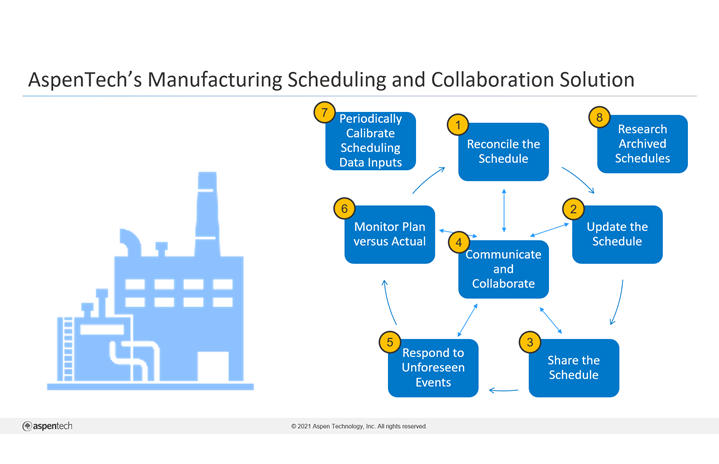The digitalization of production scheduling and collaboration processes is a topic that is being prioritized at an increasing number of process manufacturing companies. Just a couple of weeks ago, another AspenTech customer embarked on an initiative to start rolling out the AspenTech scheduling and collaboration solution across their global chemicals manufacturing sites. I learned via our technical champion that his company’s Chief Information Officer (CIO) and Chief Digital Officer (CDO) are very excited about this initiative.
This customer’s decision to roll out the solution was based on the success of their first AspenTech scheduling and collaboration implementation at one of their more challenging manufacturing sites. The thought was that if it was successful there, it would meet the needs of their other global manufacturing sites. The production resources at the site include a mixture of continuous and downstream batch production units. Some of the scheduling complexities that were incorporated into the deployed solution include:
- Complex inventory storage constraints related to time effective railcar availability
- Time effective production rates and daily rate change limits related to the continuous production unit
- Sequence dependent changeover times and costs related to the batch production units
- Physical plumbing constraints that restrict the material flow between upstream and downstream production resources
Our customer also had the objective of leveraging mathematical optimization (Mixed Integer Programming) to eliminate the risk of overlooking the vast amounts of demand and supply constraints as part of their scheduling process. The factors are numerous and include demand satisfied and associated revenues, demand shortfall penalties, production costs, transition costs, tier-based inventory target penalties and inventory holding costs to name but a few.
The AspenTech scheduling and collaboration solution is quite flexible and powerful. It can handle the full spectrum of manufacturing plants—from simple to highly complex—and all types of production operations (continuous, semi-continuous and batch).
The following is an illustration summarizing the work processes that our solution can enable:

1. Reconcile the Schedule
On a daily or intraday basis, the schedule needs to be reconciled to account for what happened since the last time the schedule was published, and rolled forward to the current date/time, before making updates to the schedule. The AspenTech scheduling solution is typically integrated with the ERP system (most often SAP) to get master and transactional data from the ERP and publish back planned and process orders to the ERP. The scheduling solution is sometimes integrated with a process data historian which contains tank inventory levels that are loaded into the scheduling solution.
2. Update the Schedule
A scheduler will periodically generate new production for the next schedule period as well as update the production schedule to consider things that have changed in the shorter term (cancelled customer orders, raw material receipt delays, etc.) since the schedule was last published. The scheduler will use a variety of methods, standalone or in combination, to make schedule changes. This includes manual interactive scheduling, automated routines to apply business rules, or powerful optimization methods.
3. Share the Schedule
Once the schedule is updated, the scheduler will publish it so that it becomes available via the AspenTech web schedule visibility and collaboration platform to Manufacturing Operations (plant managers, unit leaders, shift supervisors, maintenance managers, chemists, operators, process engineers, production engineers, operations managers, production preparation, etc.) and Supply Chain colleagues (raw materials planners, logistics coordinators, S&OP planners, etc.). The schedule will be reviewed during the daily site operations team meeting to get everyone aligned on the execution “game plan” for that day.
4. Communicate and Collaborate
Throughout the day, Manufacturing Operations and Supply Chain team members will use the AspenTech web schedule visibility and collaboration platform to visualize the most recent published schedule and associated reports, notify others of production or supply chain issues in advance or as they occur, collaborate to resolve those issues, and maintain ongoing situational awareness to what is happening as it relates to schedule execution. Keeping all Manufacturing Operations and Supply Chain team members constantly aligned throughout the day minimizes misunderstandings that could lead to execution delays and costly mistakes.
5. Respond to Unforeseen Events
The ability to quickly respond to inevitable intraday supply and demand changes is extremely important. This can range from dealing with an urgent last-minute customer order (demand change) to dealing with a production unit that unexpectedly breaks down (supply change). The ability to rapidly run ‘what if’ scenarios in the AspenTech scheduling solution, decide upon the best course of action, and communicate the schedule changes via alerts back to the Manufacturing Operations and Supply Chain teams enables new levels of agility.
The AspenTech scheduling solution can be integrated with the AspenTech Predictive Maintenance solution to incorporate prescriptive maintenance alerts and determine the best time to perform maintenance to minimize overall impact on the production schedule costs and customer order commitments.
6. Monitor Plan versus Actuals
Many manufacturing sites still surprisingly track monthly production goal achievement using hand-drawn charts on a whiteboard on the production floor. Teams today can visualize production goal attainment versus scheduling targets in near real-time by leveraging the integration capabilities between the AspenTech scheduling solution and the AspenTech real-time production monitoring, analysis and visualization web solution.
7. Periodically Calibrate Scheduling Data Inputs
It is vital to ensure that the immense amount of master manufacturing data (production rates, setup times, transition times, production yields, lot sizes, etc.) used in scheduling models is calibrated periodically to ensure they are in sync with demonstrated plant, equipment and process performance. Non-calibrated scheduling models increase customer satisfaction risks since schedules are often leveraged to make customer order commitment decisions. Closing the loop between Advanced Process Control, Manufacturing Execution Systems, and Scheduling is achievable using the AspenTech Smart Calibration capability available in the scheduling solution.
8. Research Archived Schedules
Many companies have recurring meetings in which Manufacturing Operations and Supply Chain teams come together to review and analyze what contributed to late product shipments in the last month. By leveraging the ability to easily look back at previously published schedules containing comments and conversations across Manufacturing Operations and Supply Chain teams, it significantly shortens the time needed to understand the contributing causes to late shipments and make changes where possible to avoid the same problems in the future.
Process manufacturers are becoming increasingly aware of the opportunity to simultaneously improve profitability, customer service, asset utilization and topline revenue via manufacturing scheduling and collaboration. It is a powerful “force multiplier” that allows manufacturers to accomplish greater financial and operational results from their production assets and supply chain..
To learn more, visit our solutions page.






Leave A Comment